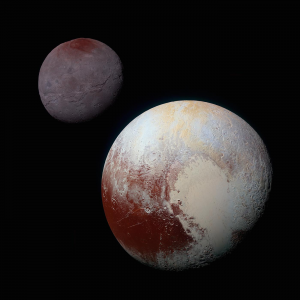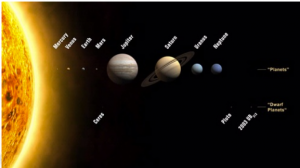Do you know what special day February 18th is? It’s Pluto Day! This national holiday celebrates the discovery of the legendary dwarf planet, Pluto.

Pluto’s Discovery
Pluto was officially discovered on February 18th, 1930, by Clyde Tombaugh, an American astronomer, in the Lowell Observatory located in Arizona. However, Tombaugh was not the one to first introduce the idea of a planet located beyond Neptune.
Percival Lowell believed there was an undiscovered ninth planet beyond Neptune because of Uranus and Neptune’s orbits. Lowell believed the wobbles in their orbits could be explained by the gravitational pull of this unknown ninth planet. Lowell died before he could discover this ninth planet, but his theories inspired Tombaugh’s search.
Pluto’s discovery was officially announced on March 13, 1930. A boy named Venetis Burney, named Pluto after the Roman god of the underworld. Burney was only eleven years old at the time and proposed the name to her grandfather, who then forwarded the name to the Lowell Observatory. The name additionally honors Percival Lowell since his initials are P.L. which matches the first two letters in Pluto.
About Pluto
Pluto is a dwarf planet in the Kuiper Belt. The Kuiper Belt is a donut-shaped region of icy bodies that lays beyond the orbit of the eighth planet, Neptune. Pluto is around 3.6 million miles away from the Sun. Because of this far orbit around the Sun, one year on Pluto is equal to 248 Earth years. This makes it so that Pluto’s day is 153 hours or six Earth days.
Pluto is very small; it is only 1,400 miles wide or ⅔ of Earth’s moon. Because of its location and small size, some argued that Pluto was just a ball of ice. This notion was debunked when NASA’s New Horizons spacecraft flew into Pluto’s orbit on July 14, 2015. The spacecraft, being the only spacecraft to ever enter Pluto’s orbit, was able to tell us more about Pluto’s surface and atmosphere.
Pluto’s surface is very icy, similar to the Kuiper Belt. New Horizons estimated that the icy surface was six miles thick. Pluto is also covered in snow. This snow is different from the snow we have on Earth because it is red, not white. Pluto’s climate ranges from -378 to -396 degrees Fahrenheit, which makes the climate too cold to possibly sustain life. However, Pluto does have high mountains and blue skies similar to Earth.
Pluto has many large glaciers. One glacier in particular is in the shape of a heart. This heart-shaped region is known as Tombaugh Regio, named after the astronomer who discovered Pluto. This region is smooth, unlike the rest of Pluto, which implies that it is a newly developed region that has no craters from meteorite impacts.
Why is Pluto a Dwarf Planet?
Pluto was originally thought to be a full planet upon discovery, but this idea was changed in 2006, when the International Astronomical Union decided to define what a planet was. To be considered a full-sized planet, the celestial body must orbit the sun, have sufficient mass to assume hydrostatic equilibrium, and clear the neighborhood around its orbit. Pluto did not meet the third criteria. Since Pluto’s orbit overlaps that of Neptune’s, Pluto was disqualified from being labeled as a full-sized planet. This makes Pluto one of five dwarf planets, the others being Ceres, Eris, Haumea, and Makemake.

Now you know all about Pluto for the next Pluto Day. To celebrate, you can try viewing Pluto through setting up your own telescope or visiting a planetarium where they hold special events for the day!
Written by: Amanda Aber
Date: 2/14/2022
Citations
A&E Television Networks. (2010, March 3). Pluto Discovered. History.com. Retrieved from https://www.history.com/this-day-in-history/pluto-discovered
Choi, C. Q., & Dutfield, S. (2021, November 12). Dwarf planet pluto: Facts about the icy former planet. Space.com. Retrieved from https://www.space.com/43-pluto-the-ninth-planet-that-was-a-dwarf.html
Cornelius, D. (2010, March 10). Happy Pluto Discovery Day. Wired. Retrieved from https://www.wired.com/2010/03/happy-pluto-discovery-day/
NASA. (2021, August 5). Pluto. NASA. Retrieved from https://solarsystem.nasa.gov/planets/dwarf-planets/pluto/overview/#:~:text=Pluto%20is%20a%20dwarf%20planet%20that%20lies%20in%20the%20Kuiper,half%20the%20size%20of%20Pluto.&text=What’s%20more%2C%20its%20path%20is%20quite%20tilted%20compared%20to%20the%20planets
National Day Calendar. (n.d.). Pluto Day – February 17. National Day Calendar. Retrieved from https://nationaldaycalendar.com/pluto-day-february-17/#:~:text=Every%20year%2C%20Pluto%20Day%20on,an%20American%20astronomer%2C%20discovered%20Pluto.
3 Key Phrases:
1. Do you know what special day February 18th is? It’s Pluto Day! This national holiday celebrates the discovery of the legendary dwarf planet, Pluto.
2. Percival Lowell believed there was an undiscovered ninth planet beyond Neptune because of Uranus and Neptune’s orbits. Lowell believed the wobbles in their orbits could be explained by the gravitational pull of this unknown ninth planet. Lowell died before he could discover this ninth planet, but his theories led to Tombaugh’s search.
3. Since Pluto’s orbit overlaps that of Neptune’s, Pluto was disqualified from being labeled as a full-sized planet. This makes Pluto one of five dwarf planets.
